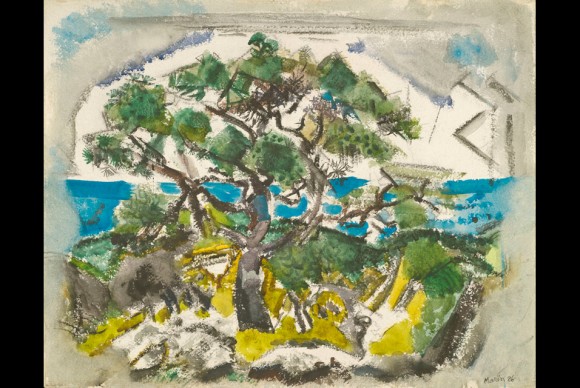Landmark Exhibition of John Marin’s Revolutionary Watercolors in Major Art Institute Exhibition
CHICAGO, IL.- In 1948, a nationwide survey pronounced John Marin (1870–1953) “America’s Number 1 artist.” Marin’s exuberant and improvisational paintings are recognized today as critical to the evolution of American modernism. Less well known, though, is the extent to which Marin pushed the limits of the watercolor medium, establishing for a new generation of artists its inherent suitability to avant-garde expression. The Art Institute of Chicago has organized a major exhibition that is the first to explore this idea through close technical analysis of the artist’s watercolor practice: John Marin’s Watercolors: A Medium for Modernism, which is on view in the museum’s Jean and Steven Goldman Prints and Drawings Galleries in the Richard and Mary L. Gray Wing (Galleries 124–127) from January 23 through April 17, 2011. This groundbreaking exhibition presents 110 stunning watercolors, oils, drawings, and etchings by Marin, ranging from early images rooted in traditional practice to more experimental compositions. At the heart of this exhibition is a group of 40 watercolors that were donated to the Art Institute in 1949 and 1956 from the collection of Alfred Stieglitz by his wife, Georgia O’Keeffe. While a few individual works from this gift have been loaned on rare occasions to other institutions, this collection has never before been presented and published in its entirety. Important loans from other Chicago collections enrich this cache of material even further. After its debut in Chicago, John Marin’s Watercolors: A Medium for Modernism will travel to the High Museum of Art, Atlanta, where it will be on view from June 26 through September 11, 2011.
The exhibition is the result of a collaboration among curators, researchers, paper conservators, frame conservators, and conservation scientists, who used the latest analytical technology to examine Marin’s artistic practice in watercolor. Once associated with young women and amateur “Sunday painters, ” the medium became, in the hands of Winslow Homer and John Marin, a theater for radical experimentation. For the first time, careful technical examination of a wide-ranging cache of watercolors reveals the artist’s working method, his modernist vision as it developed through etching and into watercolor, and his exploitation of the inherent properties of the medium to craft a new avantgarde vocabulary, which would in turn influence generations of American artists, including the Abstract Expressionists. By evaluating in depth the way Marin developed his modernist “tool kit,” this exhibition reveals important intersections between media, artistic character, and the politics of modern art, shedding new light on the question of why watercolor became such an important instrument for avant-garde artistic practice in the hands of Marin and other American artists of the Stieglitz circle, including Charles Demuth, Arthur Dove, Georgia O’Keeffe, and Marsden Hartley.
A notable aspect of the exhibition is the particular attention paid to the frames that Marin made for his watercolors. He felt strongly about the mode of presentation for the works, and his choices of frames and mounts departed radically from the ornate, European styles favored in the late 19th century. The Art Institute collection—including the 40 works from Alfred Stieglitz’s personal collection via Georgia O’Keeffe—contains the largest surviving museum holdings of Marin’s original mounts and frames, thus providing essential evidence about the presentation and promotion of modern watercolor during the first half of the 20th century. The original frames and mounts have been researched and preserved, and replica frames based on these models have been built for the works without original frames, making the Art Institute’s presentation of these works as close to Marin’s intent as possible and showing, for the first time, how Marin’s innovation and originality extended beyond his painted compositions.
Marin was born and raised in New Jersey and had what many would consider a traditional artist’s education; he attended the Pennsylvania Academy of the Fine Arts in Philadelphia and the Art Students League in New York. He traveled extensively in Europe, where he initially began developing his watercolor technique. Back in New York, Marin became a part of Stieglitz’s circle, showing regularly at Stieglitz’s galleries and beginning a relationship that would last until Stieglitz’s death in 1946. Like Winslow Homer, Marin also worked extensively in Maine. The watercolors in this exhibition span Marin’s deep interest in urban architecture and the energy of modern New York and explore his passionate relationship to the rough and dramatic Maine coastline. Marin enjoyed great success and visibility during his lifetime, both at home at in Europe, where his watercolors frequently represented the country’s avant-garde in international exhibitions. In 1936, Marin became the first American artist to be
honored with a retrospective in all media at the Museum of Modern Art.
Many of John Marin’s contemporaries often felt compelled to focus on the artist’s powerful deployment of his tools and materials when they spoke or wrote of his art. Working continuously in watercolor, and also at various times in oils, he had a very personal way of manipulating the means at his disposal: he improvised, harnessing kinetic energy and transforming it into boldly colored marks. His brush was the conduit through which his joy in the visual world traveled from his person to the flat surface of his paper. Exploring the tension between representation and abstraction, Marin conjured in line and color his visceral reactions to his favorite subjects.
Related posts:
- Exhibition of Superlative British Watercolors at the Museum of Fine Arts, Saint Petersburg
- Special Exhibition Reconsiders John La Farge’s Contributions to American Art in Centenary Year of Artist’s Death
- The Art Institute of Chicago Delves into Richard Hawkins’s Third Mind for Major Retrospective
- Pinazo and Watercolour on View at the Valencian Institute of Modern Art
- First Major Retrospective to Honor Artist Sheila Hicks at the Institute of Contemporary Art

